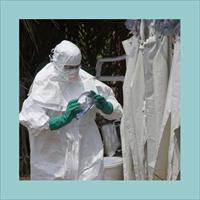SOUTH AFRICA: Congo Fever scare

At least three people have been confirmed dead in Johannesburg, South Africa, in an outbreak of what officials believe to be contagious hemorrhagic fever.
Almost one month ago, Zambian tourism operator Cecilia van Deventer was airlifted to a private hospital in Johannesburg, where she died of what health officials say is likely to be Crimean-Congo fever.
Since then, the unconfirmed illness has claimed at least two more lives, that of a paramedic who accompanied van Deventer from Zambia, and a nurse who attended to her during her stay at the hospital. Health officials are on high alert.
Crimean-Congo hemorrhagic fever was first reported in South Africa in 1981, and since then the country has usually experienced up to 10 cases annually, not all of which resulted in death, according to Dr Lucille Blumberg of South Africa's National Institute for Communicable Diseases (NICD).
Confirmation as to whether Congo fever is the cause of the recent deaths is expected late next week when the NICD delivers the findings of laboratory tests, according to Gauteng provincial health department spokesperson, Zanele Mngadi.
"It may be something else, although there are not a lot of diseases that present like this - transmission in a health care setting, high mortality and a clinical picture that would contain some bleeding," Blumberg said.
Uncontrolled bleeding from the mouth, nose or genitals are among the symptoms of Congo fever. It has a mortality rate of 30 percent, with death usually occurring in the second week of illness, according to the World Health Organisation.
Hospital spokesperson Melinda Pelser said the recent death of a cleaner was unrelated to the virus, but the provincial health department has not ruled out the possibility of hemorrhagic fever.
Infection control key
Meanwhile, health professionals working in provincial hospitals, mortuaries and ambulances have been put on high alert for patients presenting with symptoms of the fever, which initially include chills and severe muscle pains.
The NICD's Blumberg said people usually contracted the virus from tick bites or contact with the bodily fluids of infected livestock, but it could spread quickly once those infected were admitted into health care settings, especially where infection control was poor.
Pelser said doctors at the private hospital in Johannesburg had quickly identified possible cases of hemorrhagic fever and had implemented proper infection control procedures, including placing the patients in isolation wards.
She said the clinic's staff and their families were being monitored for symptoms, and two family members of the nurse who had died - although asymptomatic - had been admitted for observation.
Congo-Crimea, like Ebola, is a viral hemorrhagic fever that resides in an animal host, but is less virulent than its headline-grabbing relation. Treatment is primarily supportive, and recovery is slow.
 Back and Next - Back and Next
Back and Next - Back and Next See Also - See Also
See Also - See Also